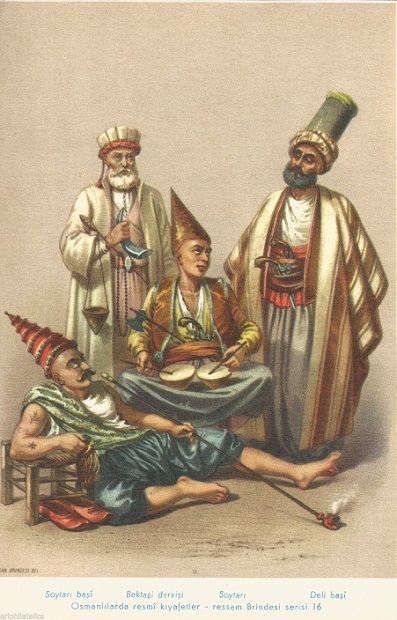Subject: درویش derviş dervish
Culture: Ottoman Turkish
Setting: Bektashi sufism, Ottoman empire 16-19thc
Evolution:
Context (Event Photos, Primary Sources, Secondary Sources, Field Notes)
* Sugar 1977 p53-54
"Unlike the akhi, the dervişes wandered almost constantly, preaching and practicing their tarikat and numerous related ceremonies. They were the babas, a sort of combination of holy man, miracle worker, medicine man, etc., and were often regarded as living saints. Their eclecticism and pragmatism knew practically no bounds. Given the numerous similarities between folk-Christianity and folk-Islam, they had little difficulty in fitting local customs into their tarikats. Furthermore, what they preached had certain advantages. The old formulae that ensured 'good fortune' were broadened by the addition of customs that they had brought with them, and by the not negligible circumstance that those who followed them passed from the zimmi to the Muslim group. What emerged was a curious variety of European, or rather Balkan, 'folk-Islam,' which included icons, baptism to prevent mental illness, and many other basically non-Muslim features."
* Nicolle/McBride 1983 p38 (reconstructing a dervish, 18th century)
"Muslim holy-men, roughly equivalent to Christian friars, despised wealth and won their living by begging. In the Ottoman Empire many retained pre-Islamic pagan Turkish practices. Those of the Bektaşi order, however, were closely associated with the Janissary corps and accompanied them on most of their campaigns."
Costume
* Rosenthal/Jones 2008 p464 (Cesare Vecellio, writing in 1590)
"A DERVISH These are another kind of religious men, who live in cities and go around begging alms. They wear coarse wool cloth down to the knee, without stockings but only with shoes. On top, they wear a short, sleeveless cape made of sheepskin or thick wool, fastened at the throat and leaving their chest bare and their arms naked; altogether they are poorly dressed. They wear a leather belt with a wooden cup hanging from it, from which they eat and drink. They cover their heads with a flat cap made of turquoise or red wool."
Ax
* Perkowski 1989 p79 (quoting an early 20th-century traveler)
"In addition to the ordinary Vrykolakas who delights in human blood, the Macedonians believe in the existence of a Vrykolakas of sheep and cattle. He is represented as riding on their shoulders, sucking their blood, and killing them. Quacks, especially Mohammedan dervishes, profess to have the power of exterminating these inferior vampires, whence they are known as 'vampire-killers,' and go about ostentatiously parading an iron rod ending in a sharp point (shish), or a long stick armed with a small axe on the top."
* Aydin 2020 p176
"In the past, hatchets were used by wandering dervishes."
